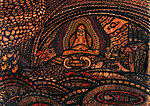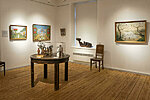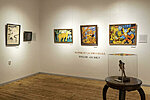23.10 - 2.12.2021
Hungarian art brut "Wildly and Passionately" from the collection of Hungarian
Naive Art Museum in Kecskemét
Naive art in Hungary extended across the whole of the 20th century and is still evolving further. The first self-taught artist to gain success was the peasant-turned-painter Péter Benedek, whose works were first presented in Vienna in the 1920s. Most of the natural-born artists, including János Gajdos and Elek Győri, started their artist’s careers at a young age between the two world wars. Nearly all of them left rural life but, due to strong attachment to peasant culture, were unable to really establish themselves in the art world. The first group exhibition of naive artists was organised in Budapest in 1934. A classic example of Hungarian naive art of that time who also gained international success with his paintings was András Süli. András György Bereczki and János Homa were prominent among sculptors. The artwork of Dezső Mokry-Mészárosi is characterised by continuous exploration of the origins of life.
A new phase in naive art started in mid-1960s, marking a return to the values of naive art. The artists representing Hungarian naive art in the following decades were mostly elderly people, who started their creative careers as well-established personalities, condensing their life's truths into paintings and sculptures. Their art is diverse. Some of them were into folk art and the world of children. This trend was represented by Antal Kapoli and Imre Tőke with their shepherd sculptures. Erzsébet Gubányiné Greksa switched from painting walls to depicting the traditions of the Kalocsa region in panel paintings.
Another important approach in the history of Hungarian naive art relates to experiences of peasant life and traditional culture. Everyday village life and festivities play an essential role in their art. Erzsébet Orisekné Farsang and Rozália Juhászné Albert recorded the experiences of their youth in a particularly rich and convincing way. Sculptures depicting historical events and figures were created, for example Ferenc Kovács portrayed one of the leaders of the Hungarian national movement, István Széchenyi.
Breaking down the relationship between man and his environment has become part of the modern attitude towards life. The works of János Balázs are deeply influenced by his solitary lifestyle and exclusion from society as a gypsy; János Répás and Irén Marosiné Földvári express their personal tragedy in their sculptures. The artwork of Imre Őrsi, who lived in complete isolation and made sculptures to serve as his companions, is an excellent example of projecting the artist’s inner vision.
The Collection of Hungarian Naive Artists was opened in Kecskemét in 1976 on the basis of the private collection and donation of film director Domonkos Moldován. Over the following decades, the valuable collections of this unique museum have grown considerably.
%20(1)-1.jpg)



